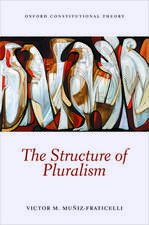Principles of Law: A Normative Analysis: Law and Philosophy Library, cartea 5
Autor M.E. Baylesen Limba Engleză Hardback – 30 iun 1987
| Toate formatele și edițiile | Preț | Express |
|---|---|---|
| Paperback (1) | 395.47 lei 6-8 săpt. | |
| SPRINGER NETHERLANDS – 31 iul 1987 | 395.47 lei 6-8 săpt. | |
| Hardback (1) | 402.98 lei 6-8 săpt. | |
| SPRINGER NETHERLANDS – 30 iun 1987 | 402.98 lei 6-8 săpt. |
Din seria Law and Philosophy Library
- 20%
 Preț: 813.10 lei
Preț: 813.10 lei - 20%
 Preț: 569.00 lei
Preț: 569.00 lei - 18%
 Preț: 1225.16 lei
Preț: 1225.16 lei - 18%
 Preț: 950.66 lei
Preț: 950.66 lei - 15%
 Preț: 583.43 lei
Preț: 583.43 lei - 15%
 Preț: 639.25 lei
Preț: 639.25 lei - 15%
 Preț: 641.53 lei
Preț: 641.53 lei - 18%
 Preț: 893.84 lei
Preț: 893.84 lei - 24%
 Preț: 797.37 lei
Preț: 797.37 lei - 15%
 Preț: 579.84 lei
Preț: 579.84 lei - 15%
 Preț: 644.95 lei
Preț: 644.95 lei - 18%
 Preț: 895.76 lei
Preț: 895.76 lei - 15%
 Preț: 644.95 lei
Preț: 644.95 lei - 20%
 Preț: 571.84 lei
Preț: 571.84 lei - 15%
 Preț: 642.03 lei
Preț: 642.03 lei - 18%
 Preț: 1232.26 lei
Preț: 1232.26 lei - 18%
 Preț: 1121.43 lei
Preț: 1121.43 lei - 15%
 Preț: 655.92 lei
Preț: 655.92 lei - 18%
 Preț: 784.48 lei
Preț: 784.48 lei - 18%
 Preț: 898.26 lei
Preț: 898.26 lei - 18%
 Preț: 1016.63 lei
Preț: 1016.63 lei -
 Preț: 390.25 lei
Preț: 390.25 lei - 24%
 Preț: 700.88 lei
Preț: 700.88 lei - 18%
 Preț: 999.60 lei
Preț: 999.60 lei - 18%
 Preț: 1115.77 lei
Preț: 1115.77 lei - 18%
 Preț: 1107.88 lei
Preț: 1107.88 lei - 15%
 Preț: 637.46 lei
Preț: 637.46 lei - 18%
 Preț: 781.94 lei
Preț: 781.94 lei - 24%
 Preț: 815.51 lei
Preț: 815.51 lei - 18%
 Preț: 786.18 lei
Preț: 786.18 lei - 18%
 Preț: 735.21 lei
Preț: 735.21 lei - 15%
 Preț: 653.33 lei
Preț: 653.33 lei - 18%
 Preț: 782.10 lei
Preț: 782.10 lei
Preț: 402.98 lei
Nou
Puncte Express: 604
Preț estimativ în valută:
77.12€ • 80.02$ • 64.46£
77.12€ • 80.02$ • 64.46£
Carte tipărită la comandă
Livrare economică 15-29 martie
Preluare comenzi: 021 569.72.76
Specificații
ISBN-13: 9789027724120
ISBN-10: 9027724121
Pagini: 424
Ilustrații: XXII, 398 p.
Dimensiuni: 155 x 235 x 28 mm
Greutate: 0.77 kg
Ediția:1987
Editura: SPRINGER NETHERLANDS
Colecția Springer
Seria Law and Philosophy Library
Locul publicării:Dordrecht, Netherlands
ISBN-10: 9027724121
Pagini: 424
Ilustrații: XXII, 398 p.
Dimensiuni: 155 x 235 x 28 mm
Greutate: 0.77 kg
Ediția:1987
Editura: SPRINGER NETHERLANDS
Colecția Springer
Seria Law and Philosophy Library
Locul publicării:Dordrecht, Netherlands
Public țintă
ResearchCuprins
Analytical Table of Contents.- 1. Introduction: A Framework for Analysis.- 1.0. Introduction.- 1.1. A Normative Approach.- 1.2. Rational Persons.- 1.3. Values.- 1.4. Legal Principles.- 1.5. Elements of a Legal Case.- 2. Procedural Law.- 2.0. Introduction.- 2.1. Aims.- 2.2. The Adversary System.- 2.3. Elements of Procedure.- 3. Property Law.- 3.0. Introduction.- 3.1. Aims.- 3.2. Forms of Property.- 3.3. Rights and Limits.- 3.4. Acquisition and Disposal.- 4. Contract Law.- 4.0. Introduction.- 4.1. Aims.- 4.2. Contract Formation.- 4.3. Duties, Defects, and Defenses.- 4.4. Discharge and Remedies.- 5. Tort Law.- 5.0. Introduction.- 5.1. Aims.- 5.2. Duties.- 5.3. Defenses.- 5.4. Remedies.- 5.5. Beyond Tort Law.- 6. Criminal Law.- 6.0. Introduction.- 6.1. Aims.- 6.2. Criminal Acts.- 6.3. Defenses.- 6.4. Punishment.- 7. Values in the Law.- 7.0. Introduction.- 7.1. A Nontheory?.- 7.2. Freedom.- 7.3. Responsibility.- 7.4. Equality and Fairness.- 7.5. Social Good.- Appendix: Summary of Principles.- Works Cited.- Table of Cases.
Recenzii
`For the important enterprise of ordering, sifting, and making the law understandable to the philosophically inclined student, Bayles' book is a major - indeed, encyclopedic - contribution. It represents a large amount of extremely competent work.'
Conrad D. Johnson, University of Maryland
`Principles of Law is one of the few books since Oliver Wendell Holmes' The Common Law to address philosophical issues at a level between the general conditions for any legal system and specific issues such as punishment or strict liability. It asks what normative principles a rational person in a contemporary common l aw society would want judges to use in deciding cases. Principles are then developed for procedural, property, contract, tort, and criminal law. The adversary model of adjudication is shown to place an important constraint on acceptable principles. ... Several features make this book a valuablesupplement for law school and other students. Chapters have a similar structure, proceeding from aims to remedies. Seventeen to 20 principles are provided for each field, and well-known American and English cases are cited. Technical legal terms are explained when introduced. The discussion is both more theoretical and concise than in many supplements.
Conrad D. Johnson, University of Maryland
`Principles of Law is one of the few books since Oliver Wendell Holmes' The Common Law to address philosophical issues at a level between the general conditions for any legal system and specific issues such as punishment or strict liability. It asks what normative principles a rational person in a contemporary common l aw society would want judges to use in deciding cases. Principles are then developed for procedural, property, contract, tort, and criminal law. The adversary model of adjudication is shown to place an important constraint on acceptable principles. ... Several features make this book a valuablesupplement for law school and other students. Chapters have a similar structure, proceeding from aims to remedies. Seventeen to 20 principles are provided for each field, and well-known American and English cases are cited. Technical legal terms are explained when introduced. The discussion is both more theoretical and concise than in many supplements.























